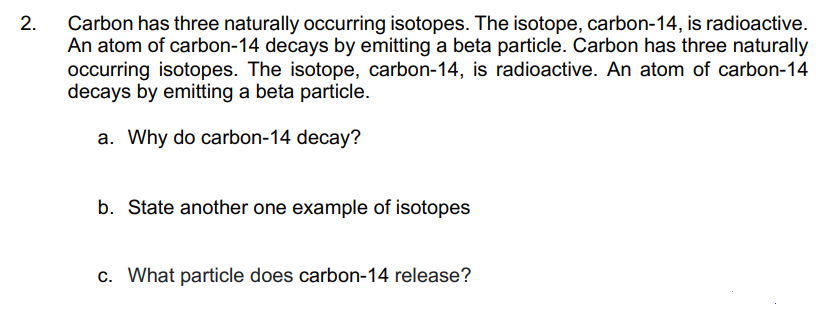Carbon has three naturally occurring isotopes. The isotope, carbon-14, is radioactive. An atom of carbon-14 decays by emitting a beta particle. Carbon has three naturally occurring isotopes. The isotope, carbon-14, is radioactive. An atom of carbon-14 decays by emitting a beta particle. a. Why do carbon-14 decay? b. State another one example of isotopes c. What particle does carbon-14 release?
Carbon has three naturally occurring isotopes. The isotope, carbon-14, is radioactive. An atom of carbon-14 decays by emitting a beta particle. Carbon has three naturally occurring isotopes. The isotope, carbon-14, is radioactive. An atom of carbon-14 decays by emitting a beta particle. a. Why do carbon-14 decay? b. State another one example of isotopes c. What particle does carbon-14 release?
Modern Physics
3rd Edition
ISBN:9781111794378
Author:Raymond A. Serway, Clement J. Moses, Curt A. Moyer
Publisher:Raymond A. Serway, Clement J. Moses, Curt A. Moyer
Chapter13: Nuclear Structure
Section: Chapter Questions
Problem 54P
Related questions
Question
100%

Transcribed Image Text:2.
Carbon has three naturally occurring isotopes. The isotope, carbon-14, is radioactive.
An atom of carbon-14 decays by emitting a beta particle. Carbon has three naturally
occurring isotopes. The isotope, carbon-14, is radioactive. An atom of carbon-14
decays by emitting a beta particle.
a. Why do carbon-14 decay?
b. State another one example of isotopes
c. What particle does carbon-14 release?

Transcribed Image Text:Tritium is an isotope of hydrogen that decays by emitting beta particles. It is used in
some luminous signs. The symbol for tritium is H.
1.
a. Determine the binding energy in units of MeV. Given the atomic mass of
tritium is 3.0160492 u
b. Describe three differences between an alpha particle and a beta particle.
Expert Solution
This question has been solved!
Explore an expertly crafted, step-by-step solution for a thorough understanding of key concepts.
Step by step
Solved in 2 steps

Knowledge Booster
Learn more about
Need a deep-dive on the concept behind this application? Look no further. Learn more about this topic, physics and related others by exploring similar questions and additional content below.Recommended textbooks for you

Modern Physics
Physics
ISBN:
9781111794378
Author:
Raymond A. Serway, Clement J. Moses, Curt A. Moyer
Publisher:
Cengage Learning

Principles of Physics: A Calculus-Based Text
Physics
ISBN:
9781133104261
Author:
Raymond A. Serway, John W. Jewett
Publisher:
Cengage Learning

College Physics
Physics
ISBN:
9781938168000
Author:
Paul Peter Urone, Roger Hinrichs
Publisher:
OpenStax College

Modern Physics
Physics
ISBN:
9781111794378
Author:
Raymond A. Serway, Clement J. Moses, Curt A. Moyer
Publisher:
Cengage Learning

Principles of Physics: A Calculus-Based Text
Physics
ISBN:
9781133104261
Author:
Raymond A. Serway, John W. Jewett
Publisher:
Cengage Learning

College Physics
Physics
ISBN:
9781938168000
Author:
Paul Peter Urone, Roger Hinrichs
Publisher:
OpenStax College

College Physics
Physics
ISBN:
9781285737027
Author:
Raymond A. Serway, Chris Vuille
Publisher:
Cengage Learning


University Physics Volume 3
Physics
ISBN:
9781938168185
Author:
William Moebs, Jeff Sanny
Publisher:
OpenStax